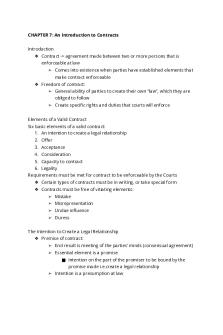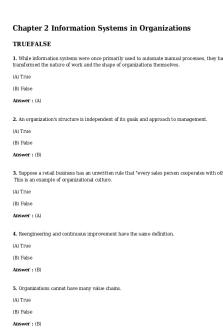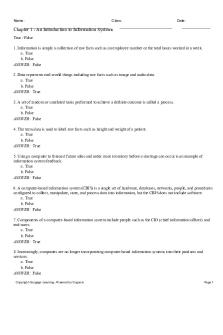Chapter 6 An Introduction to Metabolism PDF

| Title | Chapter 6 An Introduction to Metabolism |
|---|---|
| Course | Intro to Cell & Molec Biology |
| Institution | Tulane University |
| Pages | 4 |
| File Size | 136 KB |
| File Type | |
| Total Downloads | 53 |
| Total Views | 151 |
Summary
With Professor Dr. V, her lectures do not change from year to year...
Description
Concept 6.1 An Organism’s metabolism transforms matter and energy Metabolism: totality of an organism’s chemical reactions - Emergent property arises from orderly interactions between molecules Metabolic Pathways: specific molecule is altered in a series of defined steps, resulting in a product - Each step is catalyzed by a specific enzyme - Mechanisms that regulate these enzymes balance metabolic supply and demand - Manages the material and energy sources of the cell Catabolic Pathway: release energy by breaking down complex molecules to simpler compounds - Cellular respiration breaks down glucose and other organic fuels in the presence of oxygen to carbon dioxide and water - Energy stored in organic molecules become available to do work Anabolic Pathway: consume energy to build complicated molecules from simpler ones - Biosynthetic pathway - Synthesis of amino acids from simpler molecules and the synthesis of proteins from amino acids Bioenergetics: study of how energy flows through living organisms Energy: the capacity to cause change - Matter does work which makes matter move against opposing forces - Gravity and friction Kinetic Energy: energy associated with the relative motion of objects - Can do work by imparting motion to other matter Thermal energy: kinetic energy associated with the random movement of atoms or molecules - Heat: thermal energy in transfer from one object to another Potential energy: energy that matter possesses because of its location or structure - Water behind a dam has this energy because of its altitude above sea level Chemical Energy: the potential energy available for release in a chemical reaction Thermodynamics: the study of energy transformation that occur in a collection of matter - System refers to the matter under study - Surroundings refer to the rest of the universe- anything that isn’t the system - Isolated system unable to exchange energy or matter with the surroundings - Open system energy and matter are able to exchange with the surroundings First law of thermodynamics: the energy of the universe is constant - Energy can be transferred and transformed but cannot be created not destroyed - Principle of the conservation of energy Entropy: a measure of molecular disorder or randomness - The more random, the greater its entropy - Order and entropy have an inverse relation
The Second law of thermodynamics: every energy transfer or transformation increases the entropy of the universe - Order can increase locally, there is an unstoppable trend toward randomization of the universe as a whole Spontaneous process: process can proceed without requiring an input of energy - Process by itself leads to greater entropy - For a process to occur spontaneously, it must increase the entropy of the universe Living systems increase the entropy of their surroundings by reducing it within the system - Cells create ordered structures from less organized starting materials - Simpler molecules are ordered into the more complex structure of an amino acid - Ordered into polypeptide chains - Result of biological processes - Also replaces structured materials with less ordered ones - Cells break down carbohydrates into energy and releases water and carbon dioxide with less chemical energy than the carbohydrate Concept 6.2 The free-energy change of a reaction tells us whether or not the reaction occurs spontaneously Free energy: the portion of a system’s energy that can perform work when temperature and pressure are uniform throughout the system - Biologists focus on the change in free energy
-
Reactions with negative G can occur with no input of energy - A system must lose free energy during the change from initial to final state - Free energy can be thought of as a measure of the system’s instability, the tendency to change to a more stable state - Unstable systems have higher G and more stable ones have a lower G - Equilibrium is the state of maximum stability - Any change from equilibrium has a positive G and is not spontaneous - Never spontaneously change from equilibrium - A process is spontaneous and can work only when it is moving toward equilibrium
Exergonic Reaction: a net release of energy - Loses free energy and has a negative change in G - Reactions that occur spontaneously (energetically favorable)
- Greater decrease in G the greater work that can be done Endergonic reaction: one that absorbs free energy from its surroundings - G increases by storing free energy in molecules - Nonspontaneous reactions and change in G is the amount of energy required for the reaction to happen The fact that metabolism is never at equilibrium is one of the defining features of life - If they did the cell would die - The key to maintaining this lack of equilibrium is making the products of one reaction the reactants of the other - Then waste products are expelled from the cell - As long as the cells have a steady supply of glucose, they never reach equilibrium - Glucose and oxygen are at the top of the energy hill and carbon dioxide is at the bottom - Organisms are open systems - Sunlight provides a daily source of free energy for an ecosystem’s plants and other photosynthetic organisms - Animals use the organic products of photosynthesis for free energy Concept 6.3 ATP powers cellular work by coupling exergonic reactions to endergonic reactions A cell does three main kinds of work: 1. Chemical work the pushing of endergonic reactions that would not occur spontaneously a. The synthesis of polymers from monomers 2. Transport work the pumping of substances across membranes against the direction of spontaneous movement 3. Mechanical work: beating of cilia, contraction of muscle cells and the movement of chromosomes during cellular reproduction Energy coupling: the way cells manage their energy resources to do this work - The use of an exergonic process to drive an endergonic one ATP: contains a sugar ribose, the nitrogenous base adenine and a chain of three phosphate groups - Also one of the nucleotide triphosphates used to make RNA - Bonds between the phosphate groups can be broken by hydrolysis - Terminal bond being broken is caused by the addition of a water molecule becoming ADP - Reaction is exergonic and releases 7.3 kcal of energy per mole of ATP hydrolyzed (-7.3 kcal/mol or -30.5 kj/mol) - This is measured under standard conditions - ATP and water have high energy relative to the products ADP and a phosphate group - The phosphate bonds themselves are not particularly high in energy and are
-
fairly easy to break Energy from hydrolysis comes from the relative free energy change to a state of lower free energy
Phosphorylation: the transfer of a phosphate group from ATP to some other molecule (reactant) - Phosphorylated intermediate: Recipient of the phosphate group being covalently bonded to it...
Similar Free PDFs

An introduction to Psychology
- 4 Pages

An introduction to sociolinguistics
- 451 Pages
Popular Institutions
- Tinajero National High School - Annex
- Politeknik Caltex Riau
- Yokohama City University
- SGT University
- University of Al-Qadisiyah
- Divine Word College of Vigan
- Techniek College Rotterdam
- Universidade de Santiago
- Universiti Teknologi MARA Cawangan Johor Kampus Pasir Gudang
- Poltekkes Kemenkes Yogyakarta
- Baguio City National High School
- Colegio san marcos
- preparatoria uno
- Centro de Bachillerato Tecnológico Industrial y de Servicios No. 107
- Dalian Maritime University
- Quang Trung Secondary School
- Colegio Tecnológico en Informática
- Corporación Regional de Educación Superior
- Grupo CEDVA
- Dar Al Uloom University
- Centro de Estudios Preuniversitarios de la Universidad Nacional de Ingeniería
- 上智大学
- Aakash International School, Nuna Majara
- San Felipe Neri Catholic School
- Kang Chiao International School - New Taipei City
- Misamis Occidental National High School
- Institución Educativa Escuela Normal Juan Ladrilleros
- Kolehiyo ng Pantukan
- Batanes State College
- Instituto Continental
- Sekolah Menengah Kejuruan Kesehatan Kaltara (Tarakan)
- Colegio de La Inmaculada Concepcion - Cebu













